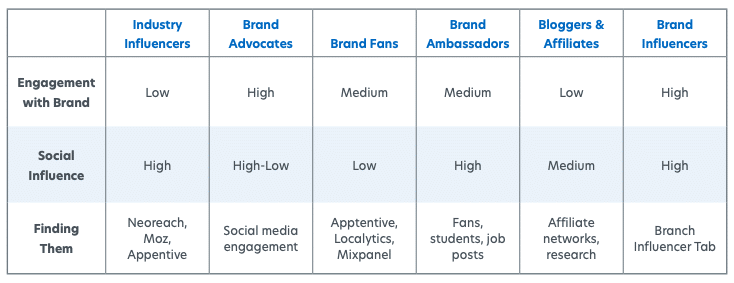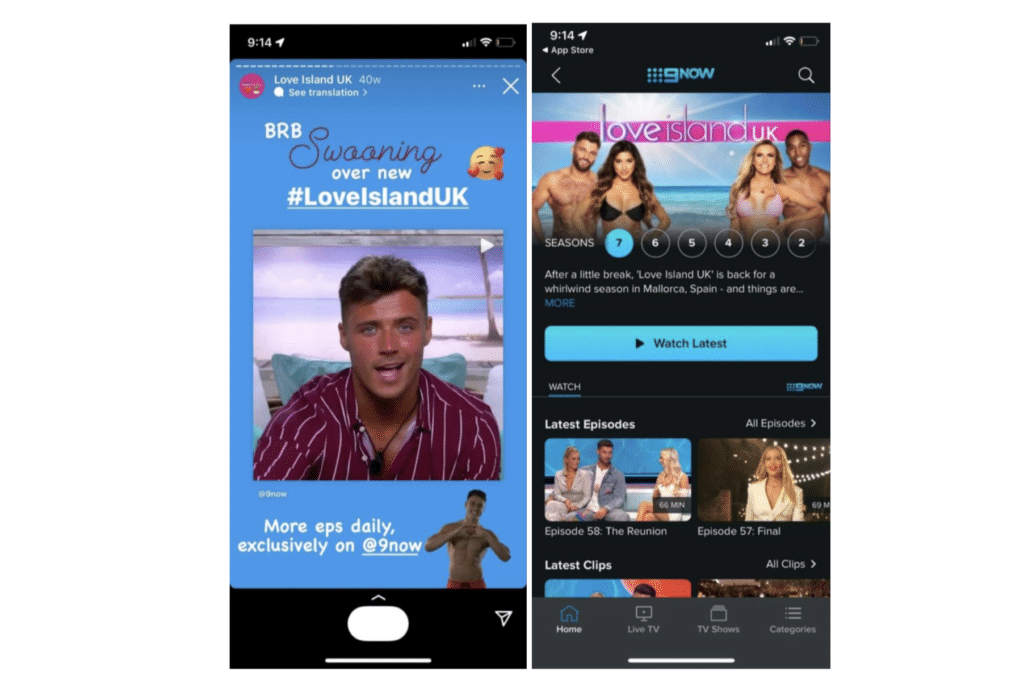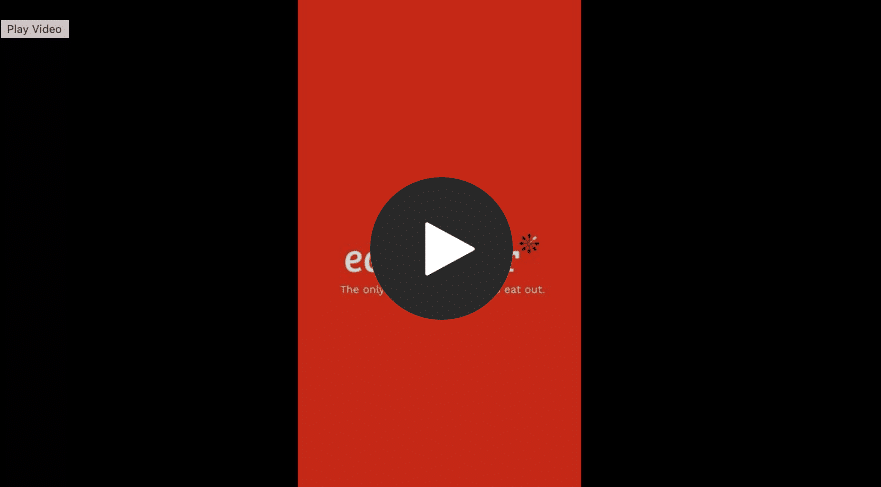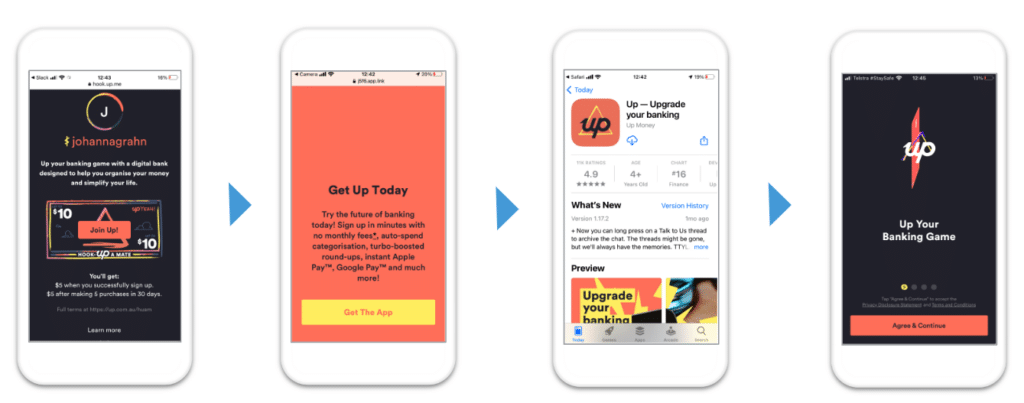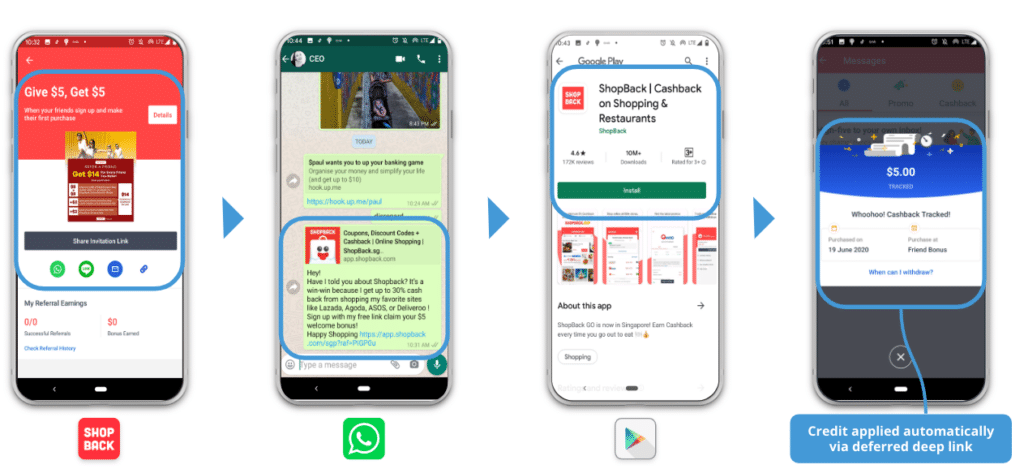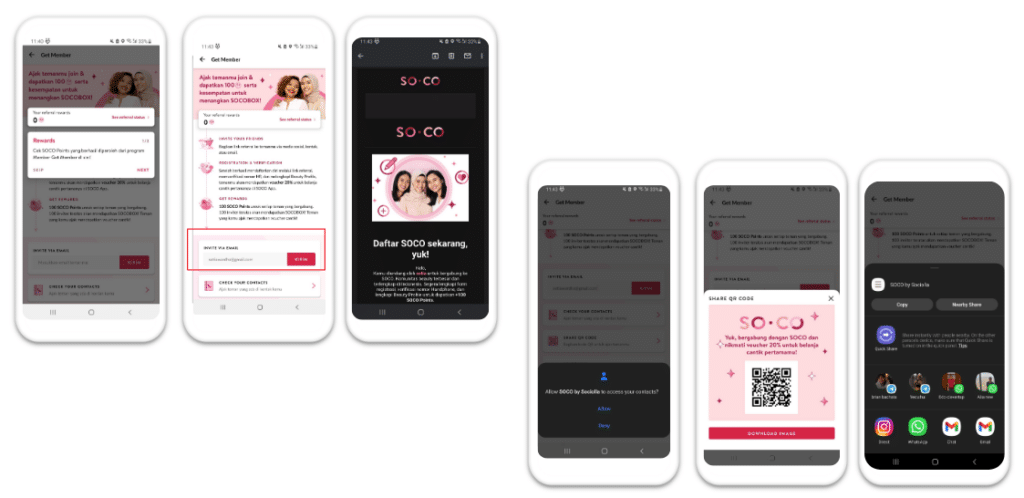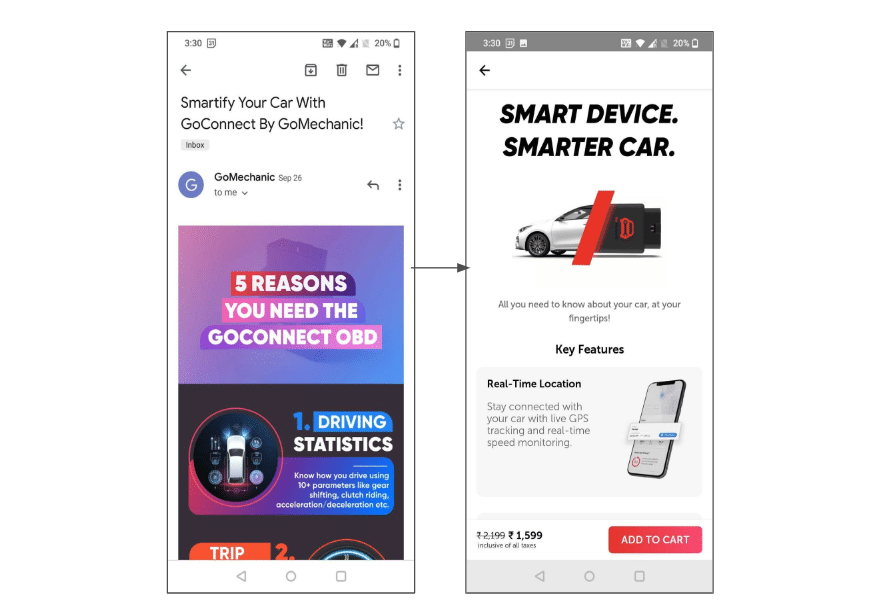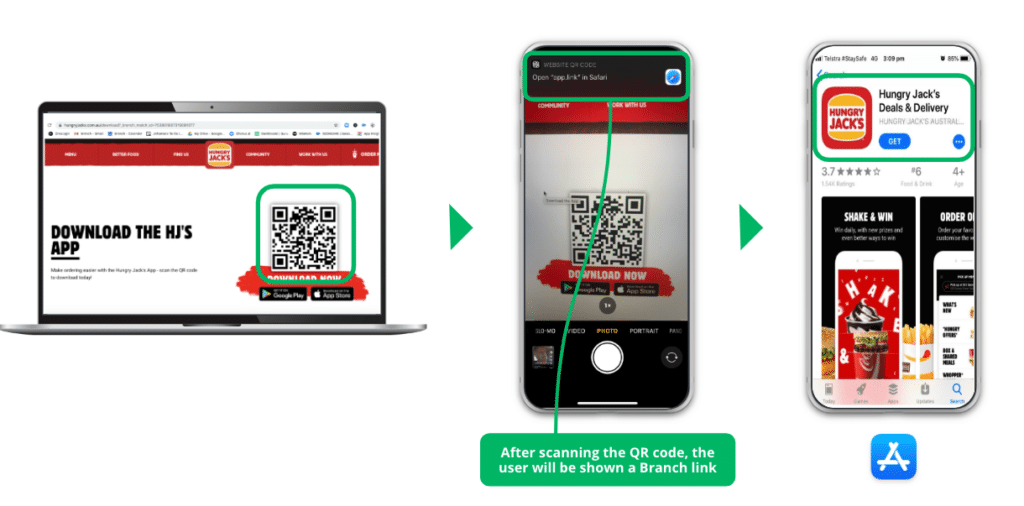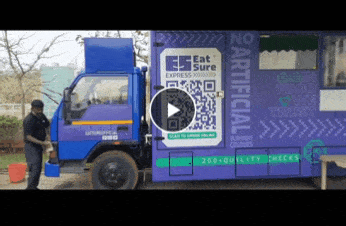Mobile user acquisition is based on a multi-pronged strategy that focuses on building a better user experience. But it’s tough to stand out from the crowd. There are 5.7 million mobile apps globally, with 3.5 million on Google Play and 2.2 million on iOS.
To one up your competition and increase app downloads, you need to cast a wider net across different platforms—owned, earned, and paid channels. This means, meeting customers where they spend most of their time and are comfortable downloading your app when prompted with the right message.
In this guide, we’ll delve deeper into how to create a solid mobile user acquisition strategy that drives app downloads, examples of successful brands implementing them, and case studies of Branch has helped brands along the way.
Table of contents:
- Optimize your website for mobile SEO to drive new users to your brand
- Implement personalized smart banners to take mobile web users to your app
- Optimize for app stores
- Run app install ads to drive users to your mobile app
- Optimize your social media channels to drive user engagement
- Create a referral program for active users
- Leverage email marketing
- Use QR codes to fill in gaps between offline and online
1. Optimize your website for mobile SEO to drive new users to your brand
Mobile searches account for 63% of organic traffic, and 75% of searchers never scroll past the first page of Google search results. This means search engine optimisation (SEO) sits at the top of the mobile user acquisition strategy funnel. But driving organic, content-driven user acquisition can be tough.
Here’s a breakdown of Google search results, from Google’s content to AMP and organic content. Notice the limited space of organic content compared to Google and AMP content.
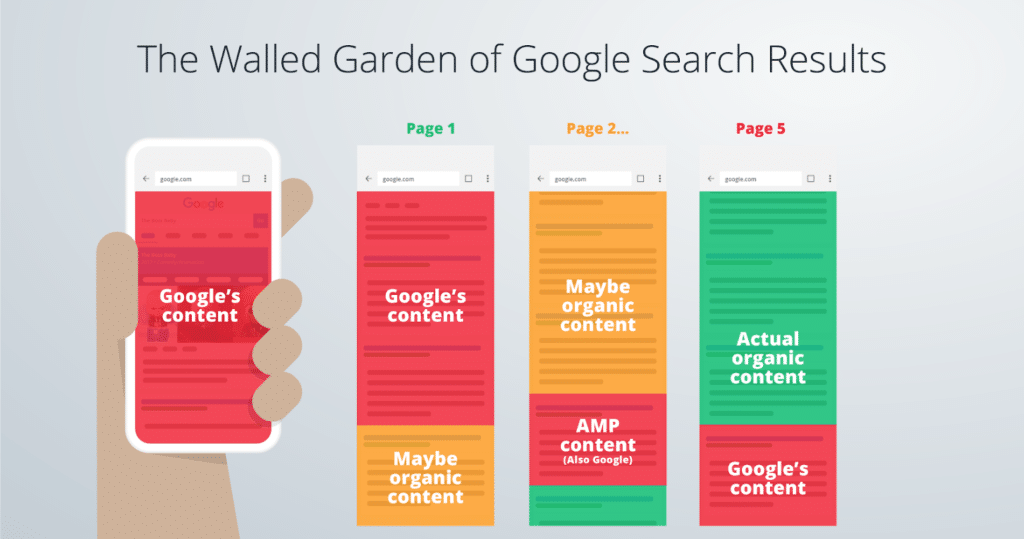
Walled Garden of Google Search Results
Evidently, Google is increasingly becoming a pay-to-play environment, just like other platforms like LinkedIn, Instagram, and Twitter that have in-app browsers to keep users inside their ecosystem. So it’s crucial to put efforts into your organic content strategy to rank better against fiercer competition and create a seamless web-to-app transition for your users to break out of those walled gardens.
This is where mobile SEO comes in.
Customer journeys are no longer linear, and their actions depend heavily on whether your brand is relevant, helpful, and personalized. SEO plays a major role in helping you predict intent and anticipating your customers’ needs, which you can use to further optimise your mobile website.
Here are some examples of how brands are optimizing their mobile SEO for better user experience:
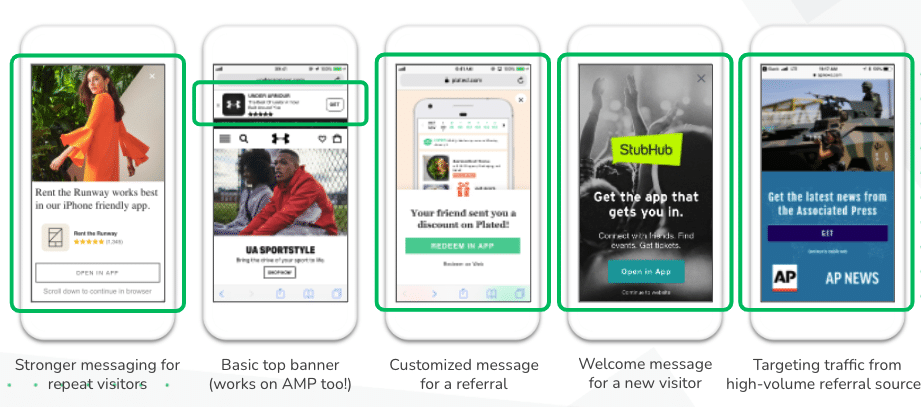
Optimise your mobile web to route users to your app
Now, let’s dig into some of the mobile SEO strategies we’ve seen work incredibly well for brands:
- Focus on mobile user experience: Look beyond just integrating responsive design. Ensure you have the right pop-ups and banners in place for your mobile users that streamline their user experience. For example, ensure a seamless mobile web-to-app transition while preserving the context of their user journey.
- Understand mobile user search intent: Take a look at specific mobile user stats before you dive into your keyword research. Then create content that closely matches the results on the first position of the SERPs.
- Build a solid link architecture: Google is increasingly effective at matching search intent to corresponding page types — product pages, category pages, or articles. You can match the exact keywords with page types and help bots crawl your website pages that match your users’ intent.
- A/B test your mobile elements: Test different versions of your landing pages, banners, pop-ups, product specification layout, images, and CTA’s to understand what works best for your users.
- Focus on local SEO: As local searches have become more specific, brands are uncovering opportunities to reach their target audience. Setting up a Google My Business profile allows local companies to rank higher in local searches. You can also identify and optimise for specific keywords that are more relevant in your local searches to make it easier for your users to find you.
In one of our recent webinars, Mobile SEO in 2022, Ethan Smith, CEO of Graphite, and Mada Seghete, co-founder and VP of marketing at Branch, delved into this topic and more.
2. Implement personalized smart banners to take bridge the web-to-app journey
Smart banners are the solution to broken user experiences. They enable an effortless transition from web to app to ensure a customer takes the desired action. Smart banners are also a great way to rev up “purchasing intent”—in other words, to motivate target users to purchase from your app.
Smart banners like Branch’s Journeys help marketers create more intelligent, high-quality, and personalized banners. You can even create customized CTAs based on different audiences and their specific behaviors across both mobile web and your app.
For instance, you can show one banner to your existing app users, like a specific product offer. Then, you can show another banner to your mobile web traffic with different content, layout, and CTA, like asking them to download the app.
Journeys also give you the flexibility to test and optimize based on the referring source of the user. This allows you to get a closer look at your user journey and uncover key findings. Which campaigns are working best? What CTAs are driving the most traffic? How does the conversion rate differ for different referring sources?
Check out this example from The ICONIC—Australia and New Zealand’s leading online fashion, sports, and lifestyle retailer. The brand uses Branch’s deep links throughout its email campaigns. When a user clicks a product link in a newsletter, they are deep linked directly to that product or product list within the app instead of being redirected to the mobile web.

Smart banners with deep links allow you to preserve the context of a user journey. Users who do not have the app installed are directly routed to the download page in the app store. On the other hand, those who already have the app installed on their mobile device are redirected from the mobile web to the exact product page or content within the app.
Check out our blog 10 Tactics To Drive Higher Mobile App Installs in 2023 to learn more.
3. Optimize for app stores
App store optimization (ASO) is the process of improving the performance of your app to garner higher visibility within app stores. Along with ASO best practices, there are three key elements that drive users to install apps.
Discoverability
No longer is creating Excel sheets with lists of keywords the only factor that influences your app’s visibility in the app stores. Discoverability is driven by an organic keyword strategy combined with paid search.
Note that ASO is different from SEO and requires a different approach to keyword research.
For example, the on-page optimization for ASO includes app name, app description, and keywords, whereas the on-page optimization for SEO includes title, keyword density, page speed, and bounce rate.
The process of creating an organic keyword strategy for ASO begins with understanding two things—branded search and intent search. You need to figure out what motivates your targeted user and how can you present your app as the solution to their problem.
For instance, you can write a branded keyword in the audience’s local language to enhance the likelihood of them engaging with your app. Or you can also add the first few letters of branded keywords that have an overlapping audience with your brand to pull in relevant traffic to your app.
Marketers are also investing in paid ads targeted to a specific audience with keywords, ensuring they rank at the top for those searches within the app stores.
Conversion rate optimization (CRO)
There are multiple ways a user can discover your app within the app stores such as browsing, branded searches, and featured pages. CRO is the process of improving conversion rates for an app across all of these channels.
This means optimizing an app experience—specifically discoverability—to improve the chances of users downloading, engaging, and purchasing within your app. For instance, adhering to Apple’s Human Interface Guidelines which details the best way you can use different colors, layouts, and graphics to your benefit.
Accurate data and measurable insights
When you’re implementing ASO, you need to review your app’s vitals to see how it’s performing based on key metrics such as application not responding (ANR), crash rate, and excessive wakeups. So, for example, if you discover after tracking your app’s performance that it has a 6% crash rate, set up an app health dashboard so you can constantly check your crash rate and other important KPIs.
It’s equally important to draw insights based on A/B tests you might run for different versions of the app’s interface and content, paid ad campaigns, and more. Make sure to factor in other mobile analytics KPIs like visibility, conversion rate, user feedback, monetisation, and mobile growth.
4. Run app install ads to drive users to your mobile app
Of all the user acquisition strategies we’ve seen brands implementing that drive results, running app install ads is one of the most targeted and effective ones.
A breakdown of mobile growth efforts reveals that companies of all sizes continue to invest in app install ads to acquire app users despite the rising costs of paid advertising.
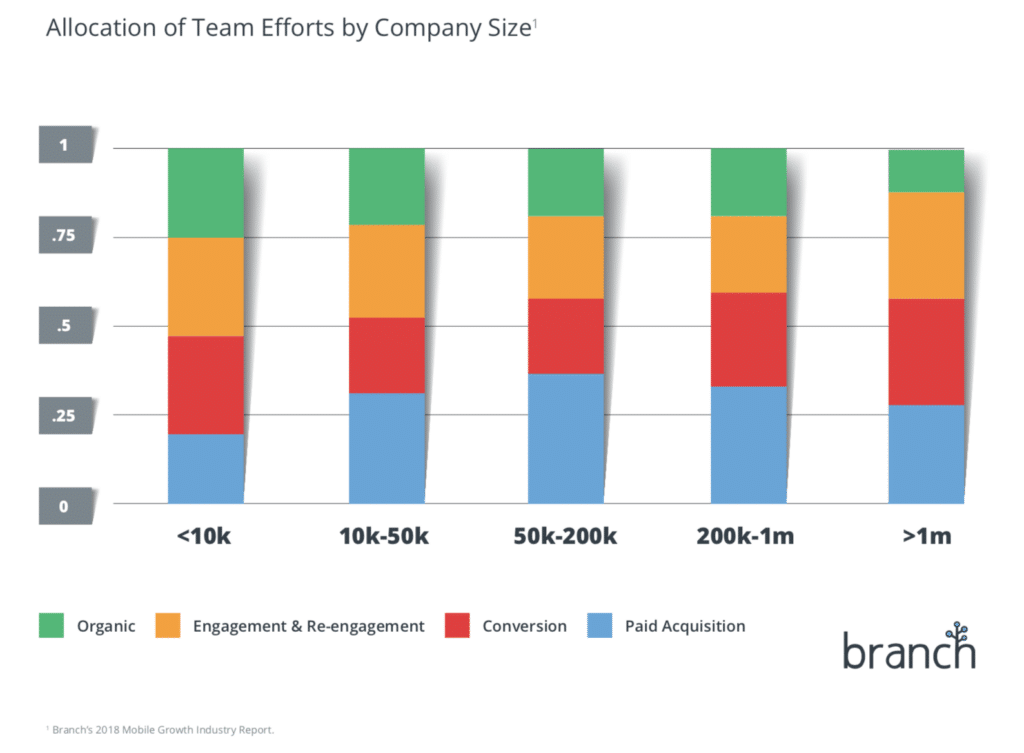
In today’s ever-more-complex purchase journey, app install ads provide a frictionless experience for users jumping from one platform to another. With a direct CTA to download an app, marketers can improve ASO, boost app store ranking, and quickly garner app installs.
A great addition to your app marketing mix can be TikTok. It helps you show your products in action and deliver tons of value in a bite-sized digestible format. TikTok ads are specifically useful for B2C mobile apps that want to piggyback on the platform’s popularity and massive reach.
With Branch, marketers can measure their TikTok campaigns by tracking their TikTok media spend and tying their return on advertising spend (ROAS) to specific in-app events tracked within the Branch SDK. This allows you to see which specific spend tactics, media placements, or strategies lead to installs and events further down the funnel like sign-ins, registrations, and purchases.
The best thing about paid advertising, like app install ads? They significantly expand a brand’s reach and visibility across every stage in the funnel, from awareness to conversion to re-engagement.
5. Optimize your social media channels to drive user engagement
The modern shopper not only turns to social media to find new apps, they actually download apps because of social media content.
Here are some tips to leverage social media to drive mobile app downloads:
Properly set up your social profile
For starters, make sure you set up your social profile properly, upload your logo, add relevant keywords in the bio, and add a short and compelling description about what your app does.
Also, optimize your social profiles with the right keywords to help them rank higher on search engines. This way, when a user searches for those keywords on their search engine or an app store, your social profile has higher visibility and thus a higher likelihood of converting users.
Invest in influencer marketing
Trust-based advertising like influencer marketing helps brands build brand awareness among their target audience. This further leads to increased engagement and conversion.
But, not all influencers have comparable degrees of audience reach or engagement. Also, a higher subscriber or follower count doesn’t necessarily mean more revenue or increased app downloads.
For example, industry influencers may have a low engagement with your brand but a high overall social influence. By contrast, your existing fans may engage with your brand quite a bit but still have a low overall influence on social media.
Brands that are ready and willing to invest in influencer marketing to promote their app should also factor in the quality of that influencer’s audience.
Here are some questions to ask yourself when choosing an influencer:
- Engagement level: How often does the influencer engage with their audience? Do they have a good engagement rate based on their follower count?
- Relevance and authenticity: Does this influencer post content related to your niche and audience? Do the influencer’s values align with your brand?
- Demographics: Will this influencer have an impact on localized app installs? What’s the upfront investment and expected ROI with an influencer vs. other paid advertising for localized app promotion?
- Cost: What’s the cost and expected ROI for partnering with the influencer?
- Sponsored posts: Has the influencer worked with brands before? What was their follower count, engagement levels, conversion rate, and ROI for previous campaigns?
- Professionalism: What does the collaboration process look like? Are they willing to commit to a specific timeline for deliverables? What is the process and associated costs for reshoots or changes?
A great example of influencer marketing done right is the #LomoStyleChallenge where Lomotif partnered with Hailey Bieber—a model, influencer, and skincare entrepreneur with 47+ million followers on Instagram. She fit Lomotif’s campaign because her brand appeals to a younger, fashion-conscious audience.
Lomotif incentivized its user base to share their go-to style pictures with a branded hashtag in exchange for a chance to win $5,000 and meet Hailey Bieber herself.
Leverage deep links
Deep links directly impact the success of your social media campaigns. They ensure your users’ journeys from social-to-app are as frictionless as possible. As a marketer, ask yourself:
- How are users being directed to the app?
- What happens if the user has the app installed on their mobile phone?
- What does the user journey look like for someone who hasn’t installed your mobile app yet?
Think of it like this: Every additional step in the user journey is another friction point in the conversion process—for example, taking users who already have the app installed to a landing page that prompts them to download the app again.. This extra step might steer them away from making a purchase, sharing a referral, or further engaging with your brand.
Social platforms act as walled gardens that keep users within their own ecosystem by automatically opening links in their in-app browsers. This means deep links become even more critical to your mobile user acquisition strategy.
Integrating Branch deep links in your organic and paid social posts provides a seamless user experience and helps you increase customer lifetime value (LTV). For example, you can route the users straight to your mobile app or app store, depending on whether they have the app installed.
Ace2Three, a leading online gaming platform, leverages Branch deep links that redirect users from the brand’s Facebook profile account to their mobile website, and then routes users to their Ace2Threetheir mobile app.
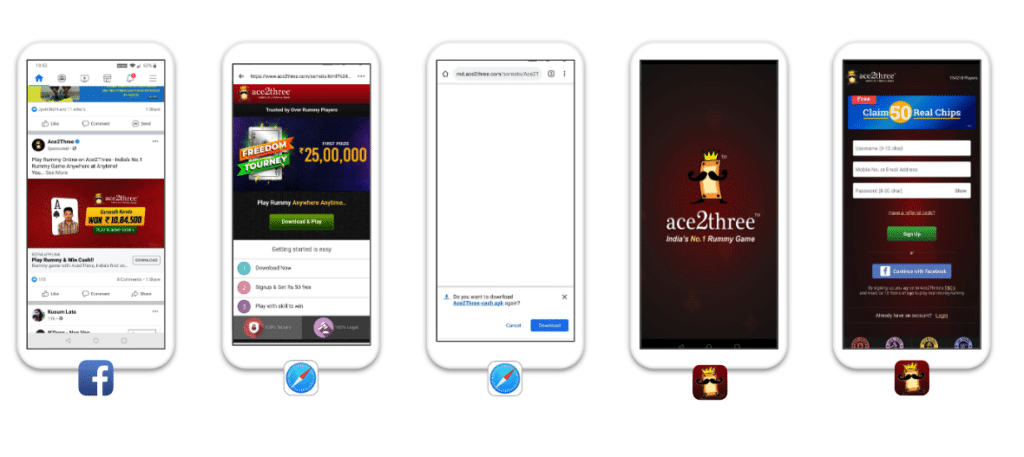
Australia’s leading OTT platform, 9Now, integrated Branch deep links across its social media content—including Instagram posts, stories, and bio—to redirect users straight into the 9Now app.
6. Create a referral program for active users
Creating a referral program is a cost-effective way to delight active users and organically drive new users. It thrives on the social proof concept, which is when individuals look toward the choices of others before acting themselves. This model helps brands create space for themselves among their target audience by leveraging their existing audience.
An effective referral program can incentivize users to download an app and immediately refer it to their network of friends and family.
India’s largest restaurant and table reservation app EazyDiner implemented a referral program using Branch’s mobile linking platform (MLP) to reward existing users and potentially drive new customers to download the app.
Watch it in action:
But what makes two apps with the same app marketing budget end up with radically different results? One app might be struggling to acquire 100 users from its referral program while the other consistently garners 1,000 users daily.
The “winner takes all” mentality is true when it comes to referral programs. It all boils down to a concept called virality, and it’s one of the most crucial elements of mobile marketing today. Virality sits at the intersection of three key factors: incentives, ego, and emotion. Let’s see how you can integrate these factors into your referral program so it has a higher chance of going viral.
Offer tangible incentives to increase user engagement
Tangible incentives help you acquire and retain new users. An incentive can be as simple as a discount within your app, exclusive swag, an add-on product, or a level-up reward system.
Up Banking, an Australian bank, gives new users $5 to sign up and another $5 if they complete five purchases on the app within the first 30 days.
Automate referrals for quick sharing
Make referring to new user base as easy and convenient as possible. For example, when you use Branch referrals, there’s no need to manually enter promo codes. New users automatically get incentives like redeemable coupons, cashback, etc. when they download the app through a referral link.
ShopBack, Asia’s leading cashback reward program, lays out a clear value proposition—“Give $5, Get $5.” By using deferred deep linking, ShopBack ensures accurate link matching and enables user-to-user sharing.
Enable sharing on multiple platforms to reduce drop-offs
Make it easy for users to share referrals on multiple platforms by using native share sheets. Native share sheets enable users to share without ever leaving your app’s ecosystem. This allows users to quickly share referrals while reducing drop-offs.
Indonesia-based beauty and skincare brand, Sociolla, runs a referral program where users can decide how they want to share their rewards link with contacts—via QR code or other native sharing methods like WhatsApp or Instagram.
Run A/B tests to measure and build virality
A/B tests identify how different copy and creatives impact the outcomes of your referral program. To build your app’s virality, try to infuse different emotions in your copy to motivate users to take action—like referring your app to their network.
The simplest way to measure virality is to identify the K-factor. It calculates the total number of new activated users generated by an existing activated user. For larger campaigns, you can measure virality with the double viral loop:

So, when a new user engages because of a referral from an existing user, the original user is notified, which makes them more likely to re-engage with your app and share it again.
7. Leverage email marketing
About 43% of emails are opened on mobile devices. This represents a great opportunity—marketers can use deep links within emails to drive app adoption and help grow your app engagement.
But as we’ve written before, there is a disconnect between email and mobile apps that impacts the user experience and the ability to track clicks, especially on iOS. When you send an email to your contacts, they read it, click on the CTA, and are directed to the app store or your app.
Here’s the problem: Most email links are broken, and users end up in a vacuum. While it may look like you’re acquiring users from email marketing, you may very possibly be losing out on a significant number of users and driving higher abandonment rates.
To counter this, most successful email campaigns with high conversion rates use deep links throughout their emails—in the copy, images, and CTAs.
Be purposeful about where you’re sending your users
You want to redirect your active users to your app quickly—without losing their interest, the curiosity of your offer, or the intent to purchase. This is incredibly important because mobile app users drive 3x more engagement.
GoMechanic sends app users directly to the promoted content in the app, enhancing the user experience and increasing engagement.
To acquire new users who don’t yet have your app installed, you could introduce an intermediary landing page that prompts potential users with a smart banner like Journeys.
Leverage deferred deep linking when messaging prospective customers
People who subscribe to your emails aren’t necessarily your app’s users. They might have come from your blog, homepage, pop-ups on a third-party website, or even a paid advertisement. By using deferred deep linking in your email campaigns, you can provide a smooth experience for users who may not already have your app installed.
If you’re running a promotional email campaign, a deferred deep link will direct them to the app store, depending on the device they use, and then to the exact product page within your app once it’s installed.
8. Use QR codes to fill in gaps between offline and online
The pandemic pushed brands to adopt QR codes as an essential part of both their offline and online marketing strategies.
At Branch, we observed a 496% surge in QR codes as the last attributed touch before a conversion event from January 2019 to January 2021. By 2025, eMarketer predicts 10.4% of all U.S. retail sales will be made via mobile devices. This means QR codes will continue to be a critical element of user acquisition strategies.
Customers expect innovative solutions for immediate needs—they look for a different size of the same product within the retail store, quickly scan products and make payments, and use offers or discounts while they’re shopping.
To meet these expectations, brands need to deliver real-time information and immediate solutions. To do so, marketers are increasingly integrating QR codes to bridge the gap between offline and online channels.
Here are some different ways you can use QR codes to acquire mobile app users.
Connect your app with in-store to deliver more personal experiences
By using QR codes in your retail store, you can be both omnipresent and personal. Give users access to digital loyalty cards, digital coupons, product reviews, information, and personalized offers based on their previous interactions with your brand.
Tata Digital used Branch to create and place unique QR codes throughout physical stores at the point of sale to drive app installs. They incentivize customers with a “NeuPass” which offers additional discounts in the form of coins every time a customer makes a transaction using the Tata Neu app.
This approach helps brands using the Neu app to deliver a consistent experience to customers across touchpoints. It creates a holistic customer-brand relationship that’s both relevant for customers and ripe for brand engagement.
Use print media to drive offline users to your mobile app
Adding customized QR codes in print media campaigns provides a concrete access point to offline users.
Pizza Hut, one of India’s leading signature pizza chains, created QR codes powered by Branch deep links for its newspaper ads to encourage users to download their mobile app.
The best thing is Branch offers granular visibility into campaign performance, thus enabling brands to measure every scan, install, and channel conversion to accurately identify the ROI of each channel.
Reduce friction points in the web-to-app user experience
Including QR codes on your brand’s website is the easiest way to direct users where you want them to be. Instead of expecting your website users to manually look up your mobile app on their smartphone, make it easy for them to transition from web-to-app using a QR code.
Hungry Jacks is an Australian fast food franchise of the Burger King corporation that leverages QR codes to drive website visitors to their mobile app.
Using QR codes on your website saves users time and effort and makes the buyer journey more seamless. Instead of typing and searching for your app and hoping to download the right one, customers can quickly scan the QR code to open the download page and install your app.
Use QR codes for faster checkout and re-engagement
Providing mobile checkout stations with QR codes can significantly reduce billing time and remove cumbersome processes.
EatSure is an app that allows users to indulge in cuisines from around the world from various trusted restaurants in one single order. It uses QR codes in offline environments (like the side of a food truck) to help customers place orders and pay online for faster checkouts.
Place QR codes at key city locations
QR codes in key locations encourage customers to download your app on the go. For example, Cult.fit, India’s largest health and fitness brand, displays QR codes on bus stands to encourage app downloads. Once the user scans the QR code, they are taken to a Branch link that opens directly in the app or the app store.
The next steps to improve your mobile user acquisition strategy
As user acquisition for mobile apps grows more competitive, marketers are pushed to incentivize users on longer time horizons. This means giving users a seamless experience and more value in exchange for small payoffs, like scanning a QR code, clicking on a CTA in an email, and shopping from their retail stores.
Marketers that step up their user acquisition game will become indispensable change agents, even if that means experimenting with strategies like influencer marketing and channels like TikTok that were less common pre-pandemic.
Partnering with a mobile measurement platform will play a crucial role. This is especially true for performance marketers who will be able to identify the true source of conversions, measure ROI, and optimize campaigns. Moreover, with platforms like Branch, marketers can implement an end-to-end user acquisition strategy by supporting cross-channel campaigns like web-to-app, email-to-app, paid advertising, and more.
With an effective mobile user acquisition strategy in place, brands can significantly reduce customer acquisition costs, churn, and cost per install.
To learn more about how you can use Branch to drive your mobile user acquisition, book a demo with our team today.


